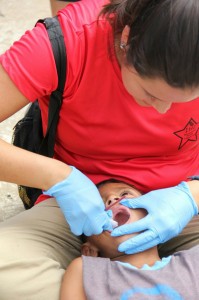CSUN Team Teaches Oral Hygiene to Rural Guatemalan Families
Determined to fight one of the most preventable diseases among children–dental caries (cavities)–California State University, Northridge professor Terri Lisagor led a team of students in November to rural Guatemala to teach families there about nutrition and oral hygiene and to be a part of a team that provides basic dental services.
Lisagor, acting chair of CSUN’s Department of Family and Consumer Sciences, and three of her students, spent two weeks traveling along Guatemala’s Rio Dulce river, as part of an international effort to improve the health of the region’s residents.
“Throughout the world, including the United States, dental disease is the number one preventable disease among children,” said Lisagor. “Not only are these children in pain, but the infection that is happening can get into the blood, which can travel to the brain or the heart, and could eventually lead to death.”
About 18 years ago, Lisagor, a Registered Dietitian, and her husband, a pediatric dentist, got involved with a program that provides free dental care and treatment to indigenous children along the Rio Dulce. The program was started by pediatric dentist Jack Faia, who learned about the problem while on a business trip with his son-in-law. Faced with the reality of the health issues the children had to endure because of the lack of dental care, Faia partnered with a local woman, Irma Holcombe, to bring relief to the children.
“When the dental clinic first started, they were treating the pain the children were experiencing from dental infection,” said Lisagor. “Originally, they would put the children on antibiotics, take out the infected teeth and basically that was it. My role as a dietitian is more about prevention. So when I went in, I said we can’t just do the teeth. We need to teach them how to prevent cavities, how to eat healthy and how to have healthy bodies.”
Nutrition and oral hygiene education was added to the International Health Emissaries (IHE) dental project in 1995. Supplementing the clinic work being done in Bacadilla, the village where the clinic is located, Lisagor started an interactive approach to target children between the ages of 5 and 17, using health promoters to teaching about how nutrition impacts oral health and overall health. She has been able to interact with 400 children each year through the education project.
“When the children come to us at five years old, many already have rampant decay,” said Lisagor. “So even though we are making great progress, the question shifted to, ‘How do we get them before they have any of these problems?’ So we came up with the idea of talking to the mothers of the very young babies and teaching them how to prevent cavities from the very beginning.”
One of the projects within the Nutrition, Dietetics and Food Science Option in the Department of Family and Consumer Sciences has been providing nutrition education to low-income families in the Van Nuys area. The students who traveled with Lisagor, including Jocceline Hernandez and Silvia Juarez-Viveros, were all a part of that effort.
“Because we’ve been working so well together these past three years, asking them to be a part of the team was the easiest thing in the world,” said Lisagor. “My dream from the start of this project has always been to bring the younger generation in to be a part of this. We were able to make this trip part of their dietetic internship rotation, gain funding and provide an excellent hands-on-learning experience. And then getting to watch my young students change the world, that was the most memorable.”
Once the whole dental team arrived in Bacadilla, where the main dental clinic was set up, Lisagor and her team of students traveled by small boat along the Rio Dulce to reach the smaller villages.
“Because we were traveling by boat, the villagers could see us from a long way off,” said Alsudairy, a CSUN student in the dietetic internship program. “So by the time we got there, the families were on the dock waiting and excited for us to help and they were eager to learn. The conditions weren’t the greatest, but they were willing to improve to help their children become healthier.”
Hernandez, also a dietetic intern, said the “trip has made it second nature for me to pass down my knowledge to people that don’t have that type of access.”
“I was also amazed at the impact we had,” she said. “During one of the last classes, I was presenting why we were there, our purpose and so forth, and after I said we’re here to give you this information that’s very important to your children, all the mothers started to clap. And to have them react that way before I had even started the lesson plan, for them to be thanking us for delivering just those few words, was so gratifying because I could tell we were there for a big purpose.”
Lisagor said her students learned as much as they taught.
“What people never tell you is that when you give to others you always get far more from them in return,” said Lisagor. “And what my students and I received was the knowledge that education is beyond the hollowed walls of a building. It’s all about working together to make a difference.”
For more information on CSUN’s Department Family and Consumer Science’s program or on the work being done in Guatemala, please visit their website at http://www.csun.edu/health-human-development/family-consumer-sciences or call at (818) 677-3051.



 experience
experience